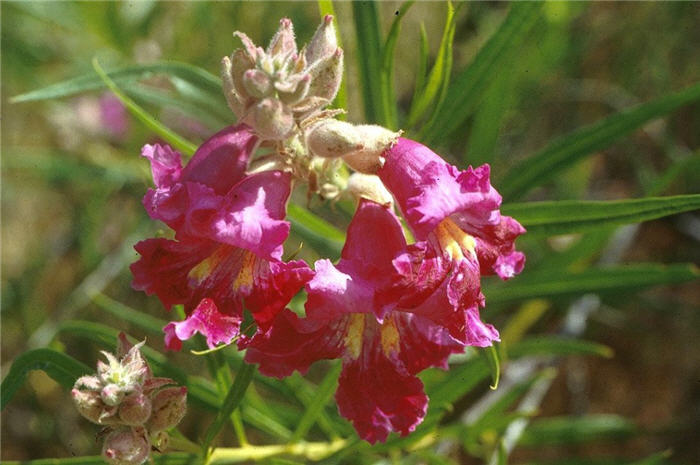| Botanical Name: Chilopsis linearis 'Burgundy Lace' | |
| Common Name: Burgundy Desert Willow |

-
Anatomy
-
Culture
-
Design
Plant Type
Tree, Shrub
Height Range
12-25'
Flower Color
Purple, Violet
Flower Season
Summer
Leaf Color
Green
Bark Color
Brown, Green
Fruit Color
Brown
Fruit Season
Summer, Fall
Sun
Full
Water
Very Low, Low
Growth Rate
Moderate
Soil Type
Sandy, Clay, Loam, Rocky
Soil Condition
Average, Poor, Well-drained, Dry
Soil pH
Neutral, Basic
Adverse Factors
n/a
Design Styles
Meadow, Mediterranean, Ranch, Spanish
Accenting Features
Fragrance, Showy Flowers, Specimen
Seasonal Interest
Winter, Summer
Location Uses
Background, Shrub Border, Foundation, Parking Strip, Walls / Fences
Special Uses
Screen, Wind Break, Fire Resistant
Attracts Wildlife
Hummingbirds
Information by: Stephanie Duer
Photographer: Susan Frommer
Photographer: Susan Frommer
-
Description
-
Notes
Burgundy Lace Desert Willow has an open, airy structure that sets this this small tree or large shrub apart in the garden. The willowy pendant branches display long, narrow leaves of soft green, and fragrant, burgundy, trumpet-shaped flowers are on display late spring into summer. Deciduous. Grows about 15 to 20 feet tall and wide; needs to be pruned to form a canopy, if one is desired. Attracts hummingbirds.
Grow in full sun in well-drained, loose soils; cannot tolerate overwatering. Cold hardy to -15F once established, but may experience some die-back in particularly hard winters or as it establishes. It does, however, thrive with reflective winter heat, so siting it against a south, west, or even east facing wall can help it over-winter. Flowers on new wood and so pruning, if necessary, ought to occur afterwards. It is quite xeric and requires no supplemental watering after establishment; however, a monthly soak will encourage better flowering.